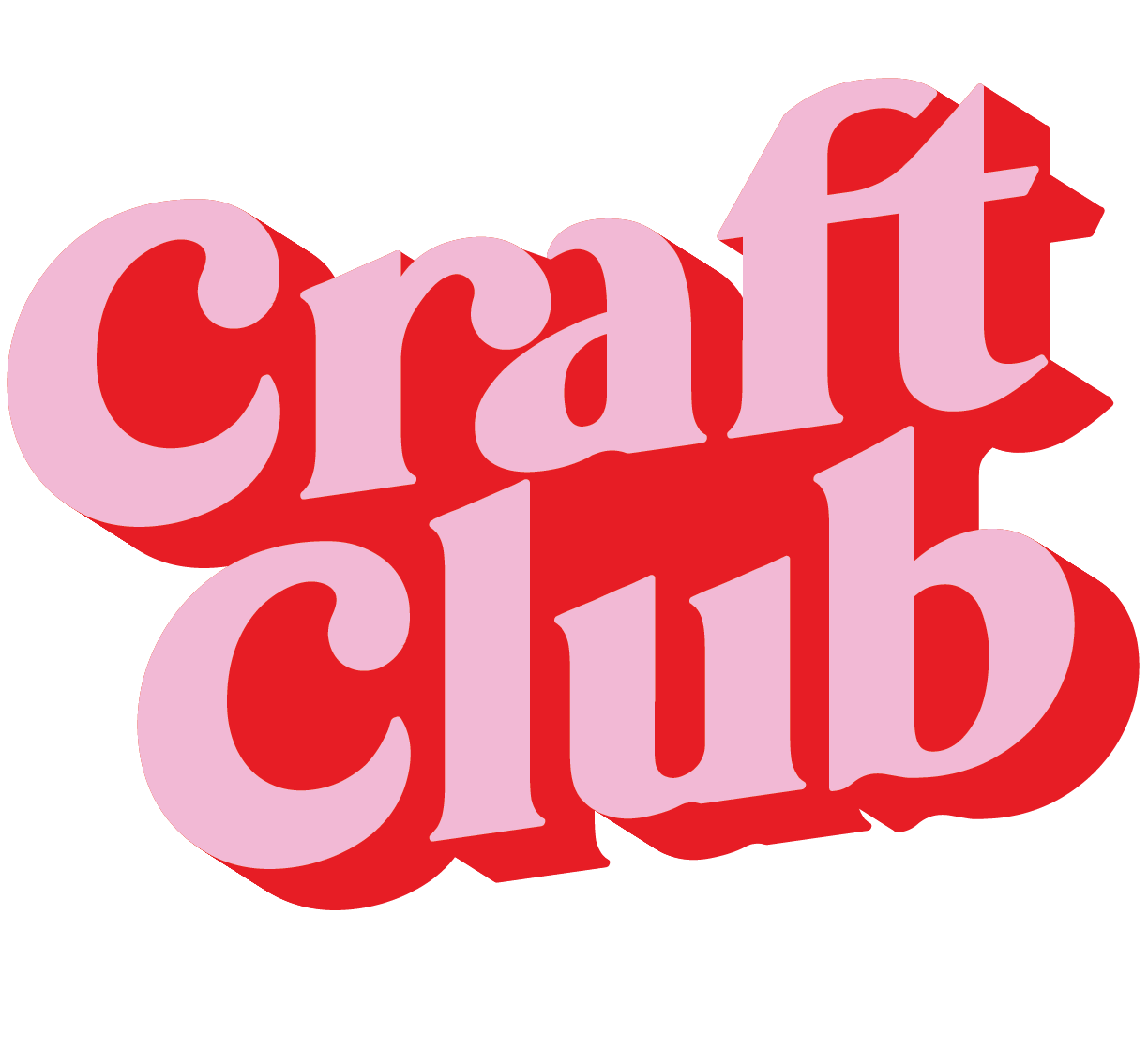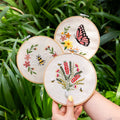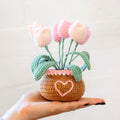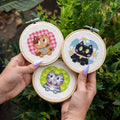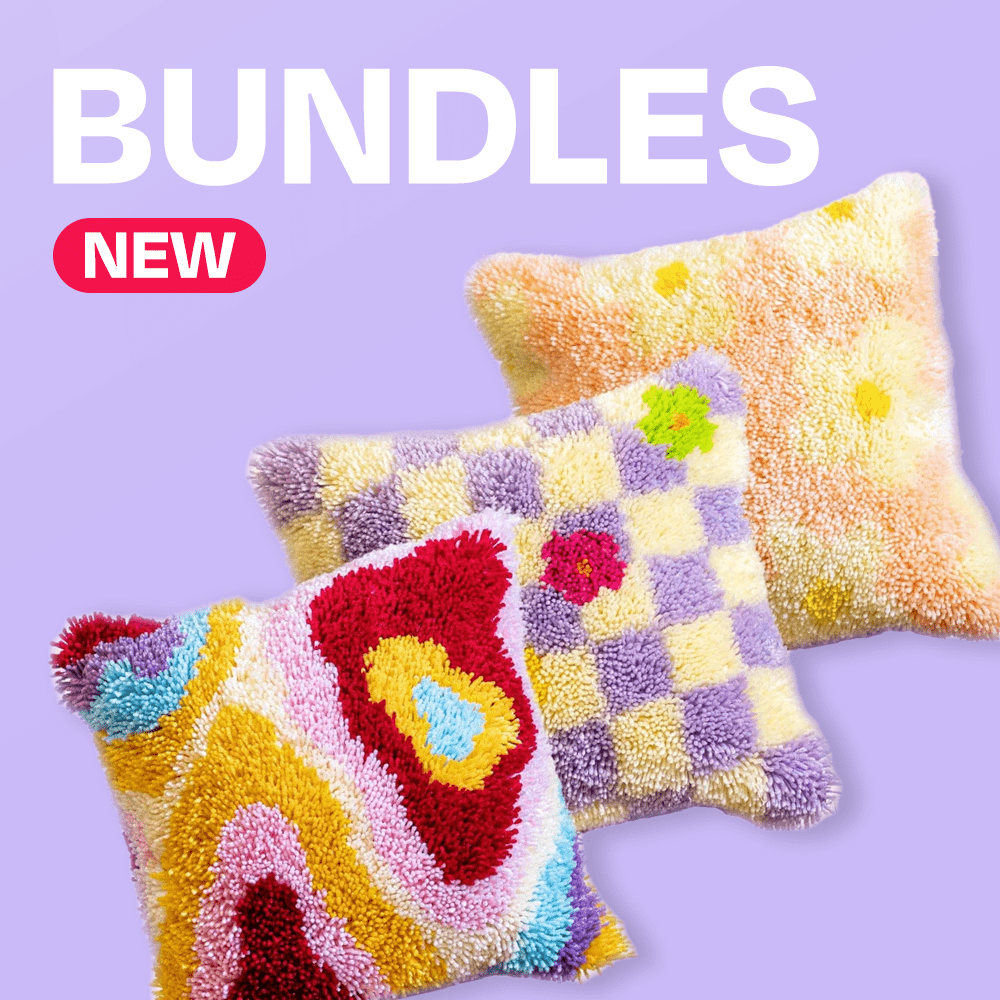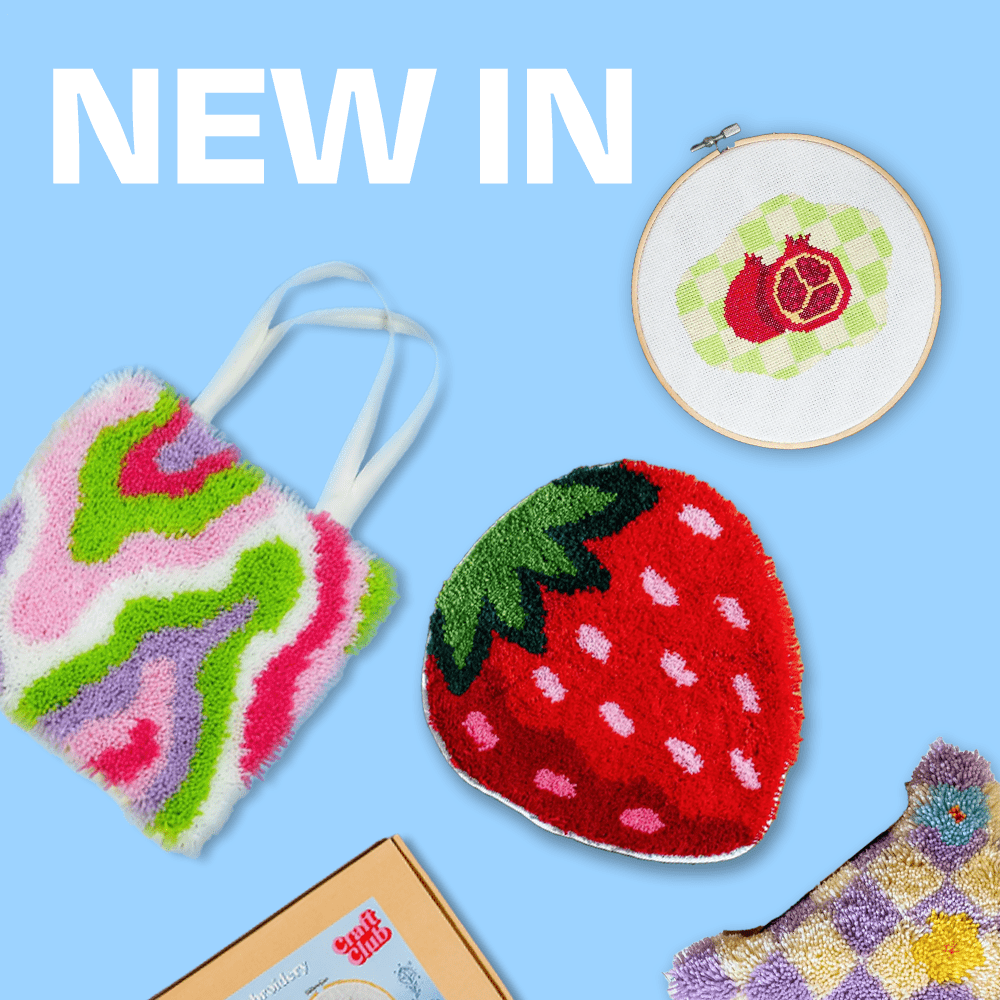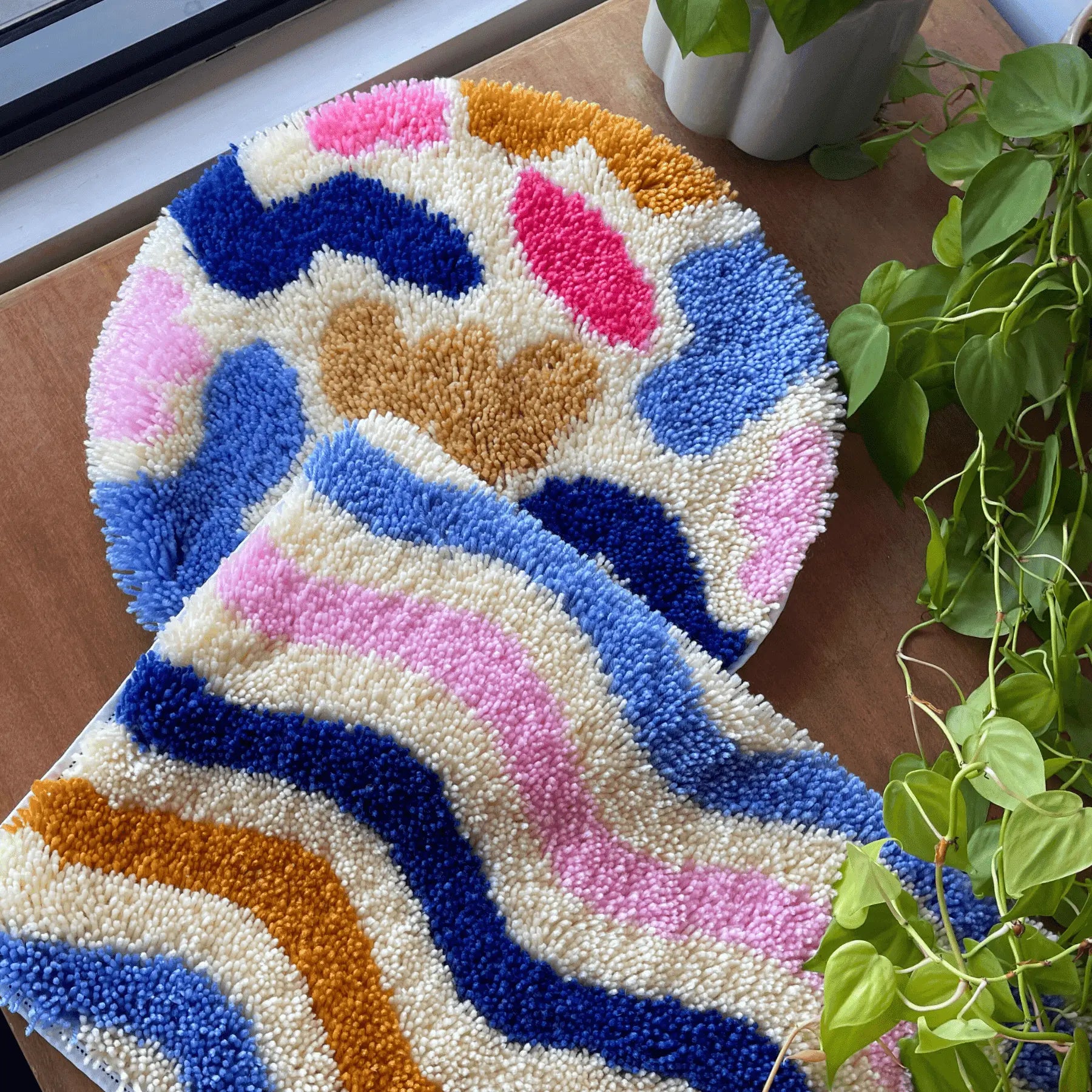Green Oasis Coaster Guide & Tutorials
Welcome to the guide for your GREEN OASIS Moss Coaster Kit!
Below you will find all the information you need to create your own mossy oasis to display on your desk or coffee table. We've designed this kit to be used as a coaster but it also makes a gorgeous decor piece for your wall or even as a landscape for miniatures.
🌼 🌼 🌼
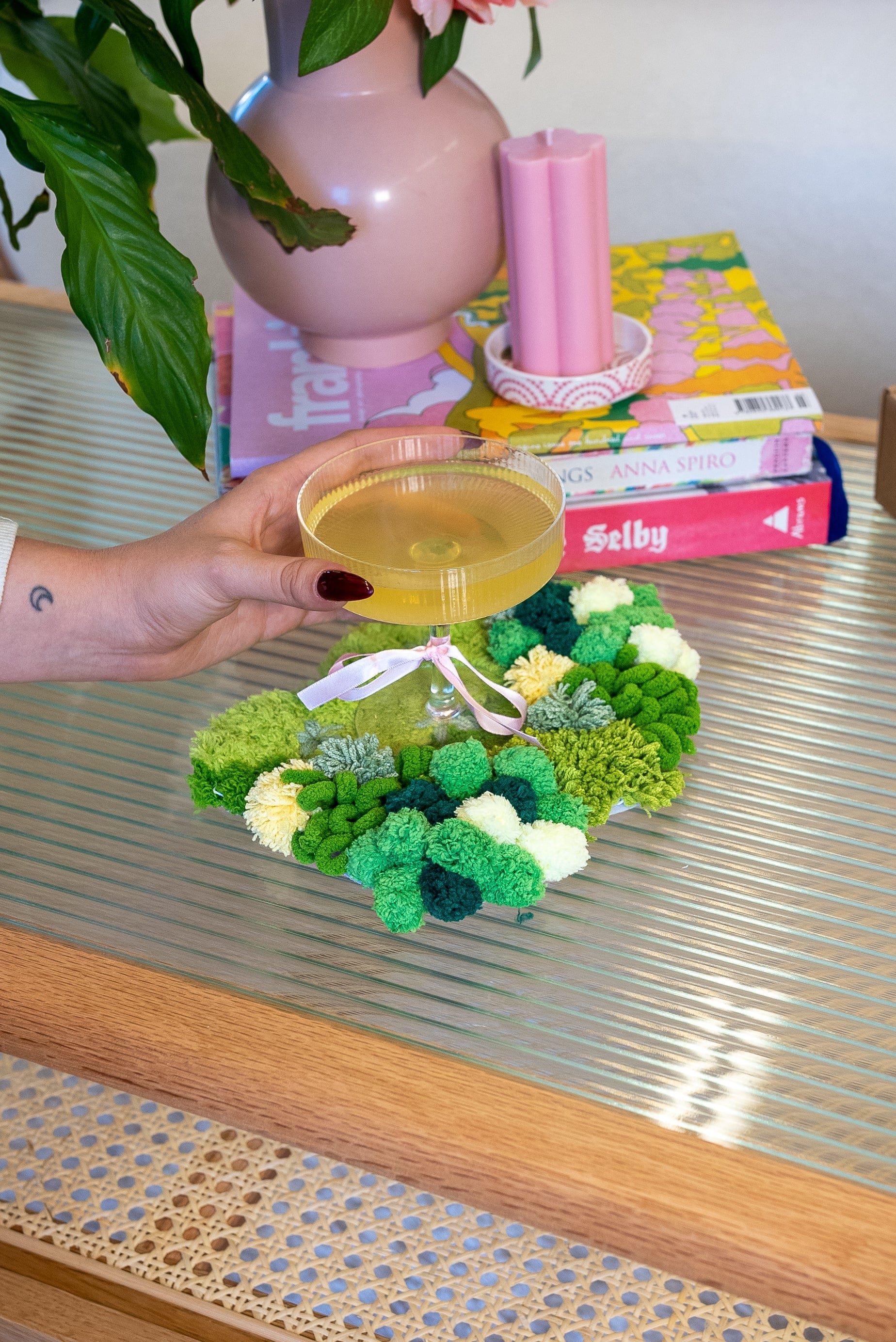
Inside Your Kit
Your moss kit includes ...
Materials & Fibre:
⭐ Latch-hooking canvas base
⭐ Felt backing
⭐ Feather yarn in 2x colours (medium green and light green)
⭐ Chenille yarn in green
⭐ Milk yarn in 3x colours (sage green, grass green and yellow)
⭐ Bobble yarn in a variegated green colour
⭐ White cotton thread
Tools:
⭐ Pom pom scissors
⭐ Small latch-hook (different tool from our other kits)
⭐ Weaving needle
⭐ Steel sewing needles
⭐ Glue spatula
⭐ Glue stick for hot glue gun (optional)
Learning:
⭐ Online instructions and video tutorials
⭐ Pattern template
Optional additions:
Our kits come with everything needed to sew the coaster backing on, but you may want to use fabric glue or hot glue if you have it handy.
You may also want to use sharp craft scissors for cutting your base. Our embroidery scissors are perfect for this project because they're small but have a sharp blade.
Green Oasis Guide
What you'll find inside your kit:
Transferring your Stencil
Your first step is to transfer your coaster design from the stencil onto your latch-hooking canvas. To do this you'll need your canvas and a marker of some kind. We recommend using a sharpie or similar permanent marker, but a regular pen or drawing marker will work just fine.
Simply lay the canvas on top of your stencil and use the marker to trace the design behind it. The stencil matches our design with the smaller shapes roughly indicating where we will stitch each type of 'moss' in the following steps.
Feel free to get creative with the shape of your design, as your coaster doesn't have to be exactly like the stencil. You could make it a little larger or smaller depending on how you'd like to use it. Just remember to leave a 1/2 inch space between your coaster shape and the edge of the canvas.
TIP: Why not move the smaller shapes around within your coaster? You can get creative with the layout.
Step-By-Step Guide
Below you'll find each of the steps to making your coaster, with recommendations on the order to stitch each element. If you're a newbie to crafting it will be worth following this step-by-step, so that you can get comfortable with the techniques and tools used in this kit.
If you want to create your own variations, you can stitch each section in whichever order you want. So don't feel constrained by our guidelines.

Step 1: Bobbles & Fuzzy Loops (using bobble yarn & chenille yarn)
Step 2: More Bobbles & Fuzzy Loops (using bobble yarn & chenille yarn)
Step 3: Feather Yarn Grass (using medium green feather yarn)
Step 4: Feather Yarn Grass (using light green feather yarn)
Step 5: 'Hair' Moss (using grass green milk yarn)
Step 6: Adding Pom Poms & Embroidered Details (using sage and yellow milk yarn)
You can also use the image below to see the details of each element on your coaster.

Step-By-Step Video Guide
This video will give you a step-by-step overview of exactly how to finish your coaster! If you're already familiar with the techniques used for moss kits, this video will be the perfect guide to help you finish.
This video will show you the steps, but it is NOT a tutorial for the techniques. For detailed tutorials, please use the videos below. Each step will have a detailed tutorial attached so that you can fully understand the technique if this is your first time making a mossy creation.
1. Weaving Bobbles & Fuzzy Loops
To start your coaster, you'll be stitching the textured section on the upper right side of your piece. Beginning with your bobbles and followed by your fuzzy loops.
To stitch your green Bobbles, you'll need your green bobble yarn and your latch-hook tool. Follow the video tutorial below to learn the technique.
Next you'll stitch your lovely textured Fuzzy Loops below your bobble yarn. For this you'll need your green chenille yarn and your latch-hook tool.
Follow the below tutorial video to create your loops.
2. More Bobbles & Fuzzy Loops
Now we're moving over to the left side of your coaster and repeating the same two techniques above. But this time we'll be adding our Fuzzy Loops first at the top of the left size, followed by the Bobbles below the loops.
Use the same tutorials from Step 1 if you need a refresher on these techniques.
3. Weaving your Feather Yarn Grass
Now it's time to weave in the 'grass' on your mossy coaster. We're going to start with the middle section of the coaster, using the medium green feather yarn inside your kit.
Follow the below video tutorial to learn how to weave your grass section. Its a very simple technique, using your weaving needle you'll be stitching back and forth to cover the canvas section.
4. Weaving More Feather Yarn
Once your middle section is done, its time to weave the bottom of your coaster using your lighter feather yarn. You'll use the exact same technique as Step 3.
TIP: You can blend your two grass colours together if you don't want a harsh line between your medium and light green patches. To do this simply stitch extra lines of your light green above the line where your medium green starts. Then use your medium green yarn to stitch some lines from the upper grassy section down across the light green. This will blend the two greens so they feel oranic, rather than split with one harsh line.
5. Creating 'Hair' Moss
This next textured section will be familiar to you if you've done one of our latch-hooking kits before. This time we use a slightly different technique to latch hook our yarn to look soft and 'hairy'.
You'll be using your grass green coloured milk yarn to create your 'hair' yarn. Cut then yarn into equal pieces using the video below. You'll be using 2x pieces per stitch to give a more dense feel. In order to make 2x pieces more manageable we use a different style of latch-hooking with this hook.
TIP: Because this coaster has a whole lot of 'hair' moss, you can create a rectangle template for trimming your yarn pieces to get it snipped even faster. To do this, cut a piece of cardboard that is approximately 1.5 inches across and 5 inches long. Take your milk yarn and wrap it around and around the 1.5 inch length of the cardboard, once its covered take your scissors and cut all along one edge. You'll be left with a bunch of 3 inch pieces! How easy was that?!
Trimming: You can either trim your latch-hooked knots as you go, or all at once at the end. We recommend giving them a very small trim first, and if you're unhappy with the length trimming them again. You can always cut your yarn shorter, but if you trim it too much on the first snip, you cant add the length back again! So snip wisely.
6. Adding Pom Poms & Shading Details
We're ready for the final touches! You'll be adding some personality to your coaster using two easy techniques: Pom Poms & Embroidery.
Starting with your Pom Poms, you'll need your sage green and yellow milk yarn.
Use the following tutorial to learn to make pom poms. For this coaster we've made 3x small sized sage pom poms with approximately 15 loops around 2 fingers. As well as 2x small sized yellow pom poms using the same 15 loops around 2 fingers.
The last step is to add some extra texture using Embroidered Details. You'll be using your sage green milk yarn for this stitching, and your weaving needle. If you have leftover yellow or grass green milk yarn, you can also use them for extra details.
You'll be stitching 3x large flowers in your sage milk yarn, using the technique shown in our tutorial below.
Backing your Coaster
Congratulations on finishing the main part of your coaster! Now you're onto the home stretch, its time to sew the back of your coaster.
There are 2x steps to finishing your coaster, which we show in the below tutorial. First you'll need to roughly trim the canvas edging and sew it down to the back of your piece.
Then it's time to back your coaster with your felt either with glue or by sewing it. If you're using it as a decor piece or to hang on the wall, it may be better for you to leave it at it's current stage. It will be easier to hang on a wall hook if the back is free from felt.
Sewing your Backing
Our kit includes all of the supplies you need to sew the backing of your coaster.
To sew your fabric you'll want to trace the shape of your coaster so that you can cut out the felt fabric to match the shape. You can do this with a pencil or pen.
You will then need to pin your felt backing to your coaster so you can begin sewing the edges. You can do this by using sewing pins, bulldog clips or even tacking the back with a hot-glue gun. I find bulldog clips the easiest method of holding my coaster to the felt.
Using 3-strands of your cotton thread, begin stitching your canvas to your mossy coaster using a whip stitch. This just means that you will whip your thread around and around the edge of your coaster as you go around. Don't worry if your stitches don't look perfectly neat, they'll blend into the grass on your coaster and won't be visible when you're finished.
Gluing your Backing
If you have any fabric glue handy or a hot glue gun then you can also glue the backing of your coaster. We've included a glue stick for a standard craft hot glue gun, as well as a glue paddle if you have fabric glue.
To glue your fabric you'll simply place fabric glue across the middle of your felt square and place your coaster on top. Allow it to dry so that the coaster is secure - you may want to put a heavy book on top of your coaster to add pressure. Once it's dry you can take a sharp pair of scissors to cut around the coaster.
You can then top up the glue on the edges, if any sections are lifting up.
Thank you!
I hope you've loved creating your very own moss coaster creation! All of these tutorials are personally written and filmed by me - Nakisah - the founder of Craft Club. I always love hearing from customers (whether you loved your experience, or there was something you'd like to give feedback on) so please come say hi at hello@craftclubco.com or send us a DM over on Instagram @craft.club.co.
I'm always working on ways to improve our kits so that they are as easy as possible for our incredible customers! So all feedback is welcome (but please be nice haha).
Nakisah x
